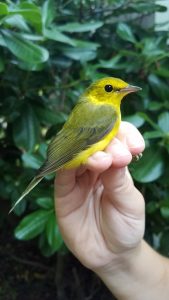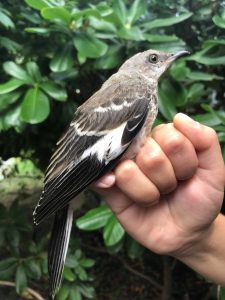
The Manomet Banders

Monday, Tuesday and Wednesday were exceptionally hot last week with temperatures in the 90s and oppressive humidity. The harsh hum of cicadas and katydids continued throughout the day as the summer heat persisted. Wind speeds were high and from the southwest but several migrant species were banded. A cold front finally rolled through and brought some relief with north winds and cooler temperatures on Friday. 96 new birds were banded as of Friday the 31st bringing the total birds banded up to 190. Additionally, we processed 58 recaptures last week bringing our total up to 106 recaptures. We’ve also had 30 species so far this season.
Migratory warblers are starting to arrive such as Black-throated Green, Mourning, and the elusive Hooded Warbler. A hatch-year Northern Mockingbird was banded on Wednesday, and the first mockingbird was banded since 2008. Fall captures of Mockingbirds are always low, with the 10-year average 0.2, likely due to their preference for open habitats and reflecting recent regional declines.

Large mixed-species flocks have been congregating around our newly created water feature in our Garden for Wildlife, including Baltimore Oriole, Black-capped Chickadee, Tufted Titmouse, and Blue-gray Gnatcatcher. Cedar Waxwings are often heard calling from the tops of trees as they feed on the ripening fruit of late summer.
On a late afternoon, Friday net run Megan saw 20 Turkey Vultures off the bluff on the beach. They were actively feeding on a carcass that had been washed in from high tide. Several gulls were also seen feeding on the carcass, but were aggressively discouraged by the Turkey Vultures.
Nick spotted a Spring Peeper and Gray Treefrog around the property, cleverly concealed in crevices under a piece of bark and a drain pipe, hiding in the cool dark away from the sun. Both these species of frogs are also heard calling sporadically throughout the day.
Hopefully, the coming weeks will bring cooler weather and migrants.
Cheers,
Brittany, Jillian, Megan and Nick





 Back to all
Back to all